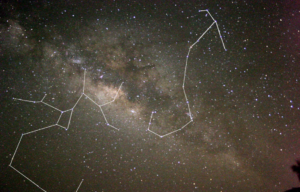 2nd Case: Locate constellations according to the time of year and recognize their brightest starsWhen planning an observation, whether you are in the Northern or Southern hemisphere, it is crucial to understand the "behavior" of the night sky throughout the year, and to know that most constellations are only visible at a certain time, while others are visible all year round from our location (those circumpolar), or others are impossible to see from our location (those located at very distant declinations with respect to the hemisphere where one is located).
2nd Case: Locate constellations according to the time of year and recognize their brightest starsWhen planning an observation, whether you are in the Northern or Southern hemisphere, it is crucial to understand the "behavior" of the night sky throughout the year, and to know that most constellations are only visible at a certain time, while others are visible all year round from our location (those circumpolar), or others are impossible to see from our location (those located at very distant declinations with respect to the hemisphere where one is located).
In this way, gradually one will be able to understand that constellations such as Scorpio and Sagittarius are not only seen at specific times of the year (summer for the Northern hemisphere, winter for the Southern hemisphere), but also that in that direction one can contemplate one of the most striking areas of the night sky, as the center of the Milky Way is located there, as seen in the image.
 3rd Case: Interpret astronomical ephemeris in the context of attempting to observe them. It is often possible to find graphics from specialized websites, reporting on some astronomical phenomenon, or observational reference, which requires knowing concepts about how the sky is "divided" into its most elementary parts, that is, into degrees, minutes and seconds of arc. These concepts in turn allow us to understand the notion of "apparent size" (or angular size), which simply tells us "how much sky space" a certain astronomical object occupies.
3rd Case: Interpret astronomical ephemeris in the context of attempting to observe them. It is often possible to find graphics from specialized websites, reporting on some astronomical phenomenon, or observational reference, which requires knowing concepts about how the sky is "divided" into its most elementary parts, that is, into degrees, minutes and seconds of arc. These concepts in turn allow us to understand the notion of "apparent size" (or angular size), which simply tells us "how much sky space" a certain astronomical object occupies.
The above allows us to understand what those graphs mean that show the differences in the apparent size of Mars, when it is at a point in its orbit far from Earth, versus when it is in opposition, that is, at the closest possible distance to our planet. These differences in apparent size will be expressed, in this case, in seconds of arc, as seen in the image on the side.


